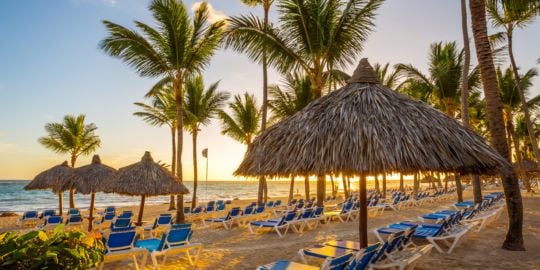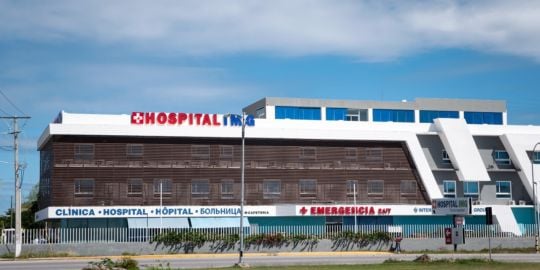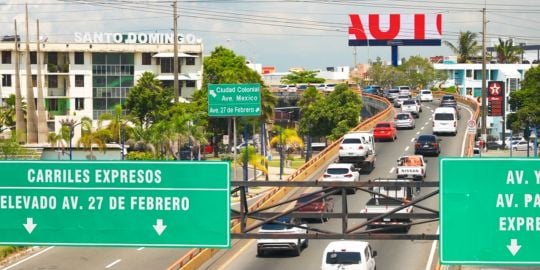Correct.
The fault line which is probably of most concern in DR and historically has been most active is the Septentrional Fault which runs from northern Haiti through Monte Cristi, Villa Vasquez, Navarette, Santiago, Moca, San Fransisco, Villa Riva and through to Bay of Samana. It is a slip slide fault that is constantly moving and this can be vividly seen from satelite images, and if you driven over the mountains to the North Coast from Moca, as you head upwards from Victor you would have come across a section of uneven road with steps (it may have been covered in the recent road upgrade but regular travellers will know to which I refer).
This fault is associated with the Caribbean Plate joint line which just offshore of the North Coast.
Earthquakes
As I understand it -
Follow that plate line westward...
Yucatan Peninsula & it turns north
becoming the San Andreas fault line
Today's devastating earthquake in Haiti should be a reminder to all of us in DR of the risk we face with this natural disaster here too in DR.
Todays quake is probaably related to movement of one of the more active fault lines that runs into DR from Haiti - the Enriquillo - Plantain Garden Fault, which runs to Azua and nor so far from the major population centres of greater Santo Domingo.
So sad that this very poor nation is suffering so much from nature amongst other things.

It is truly heartbreaking. Initial reports are showing a lot of damage and hundreds dead. Some reports suggest death toll could exceed the last one.
On top of that we are now expecting Tropical Storm Grace to add to their misery and complicate rescue efforts.
My heart goes out to Haitians. They just can't seem to catch a break. Let's hope Grace leaves them alone.
Seismology Director: "At any moment we can have a seismic event and we must be prepared"
https://listindiario.com/la-republica/2 … -preparado
The director of the Seismology Center of the Autonomous University of Santo Domingo warned that in the country at any time we can have a seismic event and therefore we must be prepared.
The seismologist Ramón Delanoy explained that what has happened in Haiti with two powerful earthquakes in a decade is due to the seismic stresses to which Hispaniola Island is subjected.
He argued that it is generally said that seismic recurrences are 50 to 100 years, but with these two earthquakes that occurred in Haiti in 11 years, it has been seen that this does not correspond to reality.
Interviewed in the D`AGENDA program that is broadcast every Sunday by Telesistema Canal 11 and TV Quisqueya in the United States, the university professor gave as an example what happened in the country between the years from 1751 to 1770.
He emphasized that with only 19 years of differences, there were two earthquakes in the vicinity of Azua, and the last tremor that is considered to be of equal or greater intensity occurred in the south central part is the 1860 earthquake. And we have had several in the eastern area. like the one in 1984 with a magnitude of 6.9 that produced a tsunami that did not cause much damage, except for some destruction in San Pedro de Macorís.
“The Island, as we know, is subject to great tensions, as a consequence of being between the North American Plate and the Caribbean Plate, and as a result of that we have had innumerable failures such as the one that caused the last two earthquakes in Haiti, which is the Enriquillo- Plantain Garden ”, explained the expert.
He argued that this fault extends throughout Haiti in the southern part and that it also affects us in the Barahona and Azua area, which in some way coincides with what is known as the “Trench of the Dead”.
"And to the North we have the contact with the North American Plate, which has its greatest depth in an area of Puerto Rico known as the Puerto Rico Trench, and which many people know as the Milwaukee Trench," he added.
The director of Seismology defined earthquakes that occur as a product of tectonic forces that at one point can manifest in one place on the Island and then in another.
“If we count 75 years ago, on August 4, 1946, we had the largest earthquake on the island that produced a tsunami and destroyed the town of Matancita in Nagua, and four days later there was one of 7.6, the first was 8.1, But it did not take two years for another 7.6 to occur, in 1948 in the same area, that is, from 1943 to 1953, in a period of ten years, there were five seismic events of magnitude greater than 6.5 degrees in the entire region. Northeast part ”, he recalled.
He defined these earthquakes as something normal on the Island, whose recurrence of 50 and 75 years between one earthquake and another is not fulfilled.
"At any moment we can have a seismic event and we must be prepared," said the director of the Seismological Center of the Autonomous University of Santo Domingo.
Delanoy says most public buildings and RD homes are not built to withstand earthquakes
The director of the Seismology Center of the Autonomous University of Santo Domingo warned that in the country most of the houses and public and private buildings are not built to withstand earthquakes similar to those that have occurred in Haiti in the last decade, and that they have caused hundreds of thousands of deaths and millionaire damage to their economy.
Says it all.

It is worth looking at this map again to understand the article better. Perhaps the stresses in the Enriquillo Plantain Garden fault have been reduced and that maybe positive for the south west. The north remains at risk and a massive quake occured on the major fault line as shown between Cuba and the Caymans a couple of years back. And we should no discount other large faults throughout DR and those offshore to north and south. The area around Puerto Plata too where many expats live is riddled with active fault lines as the quake of 6.4 in 2003 confirmed.
They regurgitate this info every few months or whenever there is an event close by. No one really pays attention to this here. Nothing changes.
At any moment there can be an event. Ok.
So this just published today, maybe they are actually going to do something....From Dominican Today:
Santo Domingo, DR.
Although one of the priorities of all Dominican rulers has been to reduce the housing deficit, the Dominican Republic does not have a robust building code but are simple regulations.
It is precisely this issue that comes to mind in the light of the earthquake in Haiti on 14 August. A problem should call the Dominican construction sector to reflect since the country needs a code that stipulates all the rules to build and design safer buildings, such as the height that a window must have according to the type of housing.
Given this reality, the creation of this code will be one of the first actions that could be carried out by the newly formed Ministry of Housing, Habitat, and Buildings (MIVHED), under the justification that in the Dominican Republic, rules from other countries are used for structural elements such as steel, when soil studies from here or national statistics should prevail.
When participating in the Breakfast of the Daily Listin, the Prime Minister of Housing, Carlos Bonilla Sánchez, maintains that the code should apply to all new buildings, being an important figure for supervision an urban manager who would belong to a certified private company to which the construction license is outsourced.
The Urban Manager
The code and the function of the urban manager will not only be limited to the public sector but also to the private sector, where structural engineers conduct vulnerability studies and certify that the construction to be developed is following the plans and rules, according to Bonilla Sánchez, during the meeting that was headed by the director and deputy director of listín, Miguel Franjul, and Fabio Cabral.
The minister who has the challenge of facing the objective for which the Ministry of Housing was created to reduce the housing deficit and that contributed to the elimination of the National Housing Institute (INVI) and the Office of Supervisory Engineers of State Works (OISOE), emphasizes that this urban manager will also have sanitary, soil, electrical and other engineers to evaluate the same processes that were reviewed in the Ministry of Public Works and Communications (MOPC).
The reason for this idea was born after a visit by Bonilla Sánchez to Colombia to learn the good deeds that the government has taken in this regard, a country where permits come out in a month. At the same time, in the Dominican Republic, they can last up to a year.
However, until the complete transition of mopc technicians to the Ministry of Housing occurs, the permits will continue to be granted in Public Works, a process in which it is expected to purge the personnel of this entity and its procedures, explains Bonilla Sánchez, who was accompanied by the Deputy Minister of Construction of the MIVHED, Danny Santos Compres; the Deputy Minister of Housing and Habitat, Ney García, and the Director of Communications of the entity, Patricia Florentino.
But we do have expats reading this forum who are building or own property and who do not come from earthquake regions, so it is important to emphasize the real and very uncertain risks.
The structural design of your property is probably more important to scrutinize than the architectural design. I have also mentioned existing properties built before 2012 need inspection and maybe strengthening to meet updated seismic codes.
As you say it falls on dead ears most of the time and throughout the country maestros are building and extending properties using their standard designs to what owners want and so often we see amazing structures that look so flimsy and unbalanced.
Ultimately it will all depend where a large earthquake hits. It wouldn't be nice if it were to hit a large populated area such as Santiago or San Francisco de Macoris which are both adjacent the main northern slip slide fault line and built largely on aluvial soil. It wouldn't be nice for me if it hit to the north where this major fault passes through Duarte province closeby.
Would not be nice regardless of where it hits here. We all need to understand that we will face weeks of issues if not months! That is the reality of choosing this country. If it is not a seismic event its a hurricane. It very much is the risk of living in Paradise.
What I found interesting above is we have not Building Code as such, just regulations. I found that shocking actually.
Yes.
It is a weak and bureaucratic process getting a construction license which includes compliance with laws and regulations and I doubt if it is done properly in most cases (which is less than 10% of all construction taking place in DR).
https://www.mopc.gob.do/servicios/dirección-oficina-central-de-tramitación-de-planos/emisión-de-licencia-de-construcción/
Emisión de Licencia de Construcción
Descripción del Servicio
Este servicio consiste en la presentación de los documentos, por parte de los ciudadanos, que especifique las condiciones legales, estructurales, arquitectónicas, sanitarias, eléctricas y de materiales, necesarios para la ejecución de cualquier proyecto de construcción; éstos deberán cumplir con todas las leyes, normas y reglamentos establecidos en el país, así como también con las características de calidad mínimamente requeridas.
The 2010 earthquake in Haiti was on the north coast.
My friends in Cabrera felt it - I felt nothing .... and am just a few hundred yards from them
Their pool was sloshing.... house shaking.... nothing for me
They are right on the waterfront..... shoreline stuff that many seek
My few hundred yards is up 300ft on a solid rock cliff.... hard to shake
Building properly is one thing.... lot selection counts too !!
Getting a bit away from the water saves on salt erosion
Up above offers a nice breeze... and view.....IMO
Hi
Where are you located ?
Because you said u never felt the earthquake.
Thanks
Cabrera..... it was felt here - but not by me
Just had a very firm short shake which made all the bottles and glasses rattle.
US Geological Survey reports it as 4.5 (UASD say 4.7) east of Bayaguana in the east of Monte Plata province/into San Pedro which is about 50km away from me.
The 'big one' will have between a few hundred and a thousand times more energy when it comes - an increase of ten times more energy for 5.5, 100 times more for 6.5 and 1000 times more for 7.5. Not sure I want to be close to a 'big one'. Have felt a long 5.3 at 5.30 am, 50m away and that was sureal - jumped out of bed and made a beeline for the outside.
Just felt a tiny shiver in Punta Cana...
Seriously felt it here in Santo Domingo. Two wine glasses broke but nothing more. Was not a long shake but it was intense.
Yep glass of wine can broke sometime in a Dominican party  seriously I don't feel nothing here in Samana
seriously I don't feel nothing here in Samana
Cheers
Hahahaha all true. Wine glasses were on a shelf, no party in progress.









